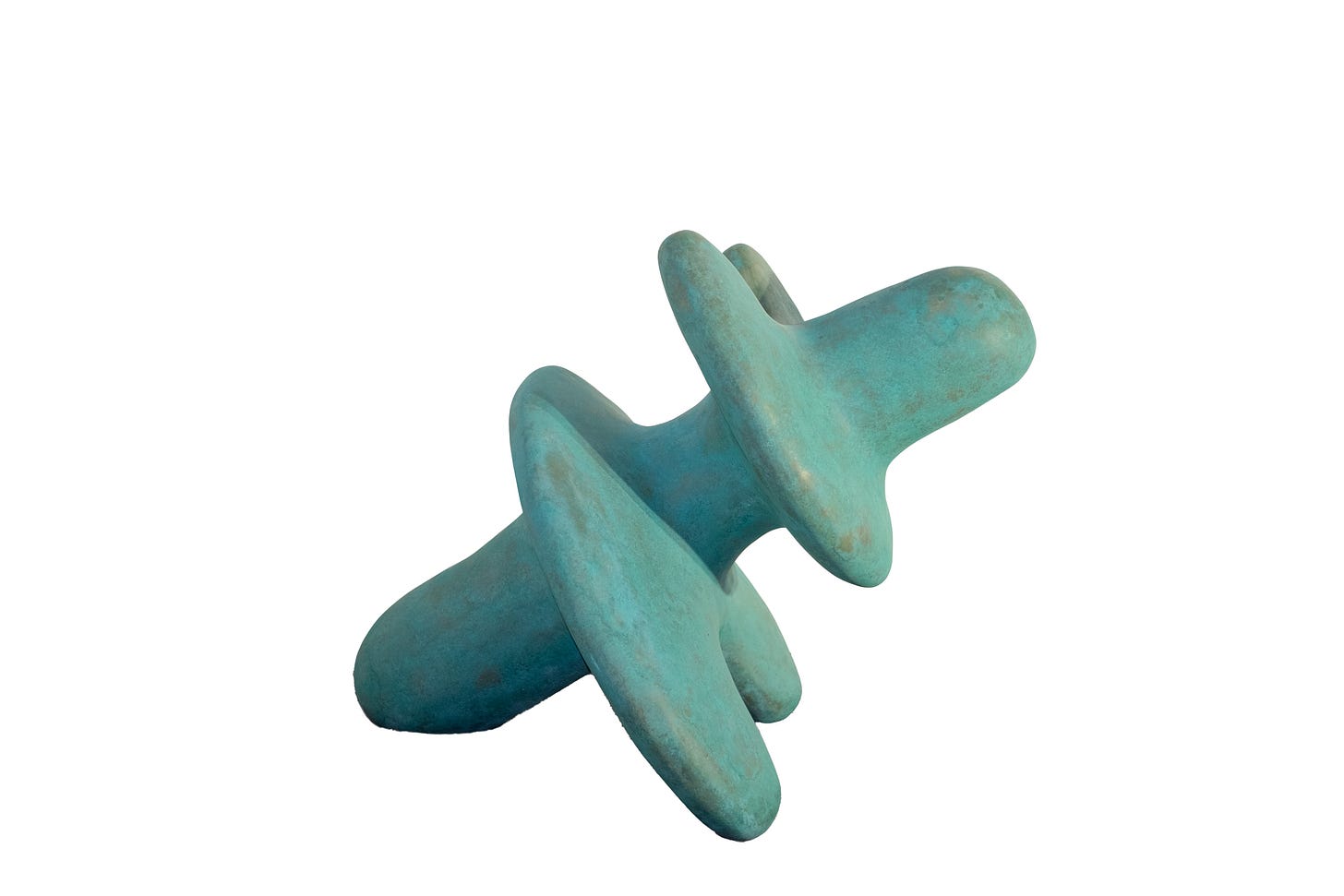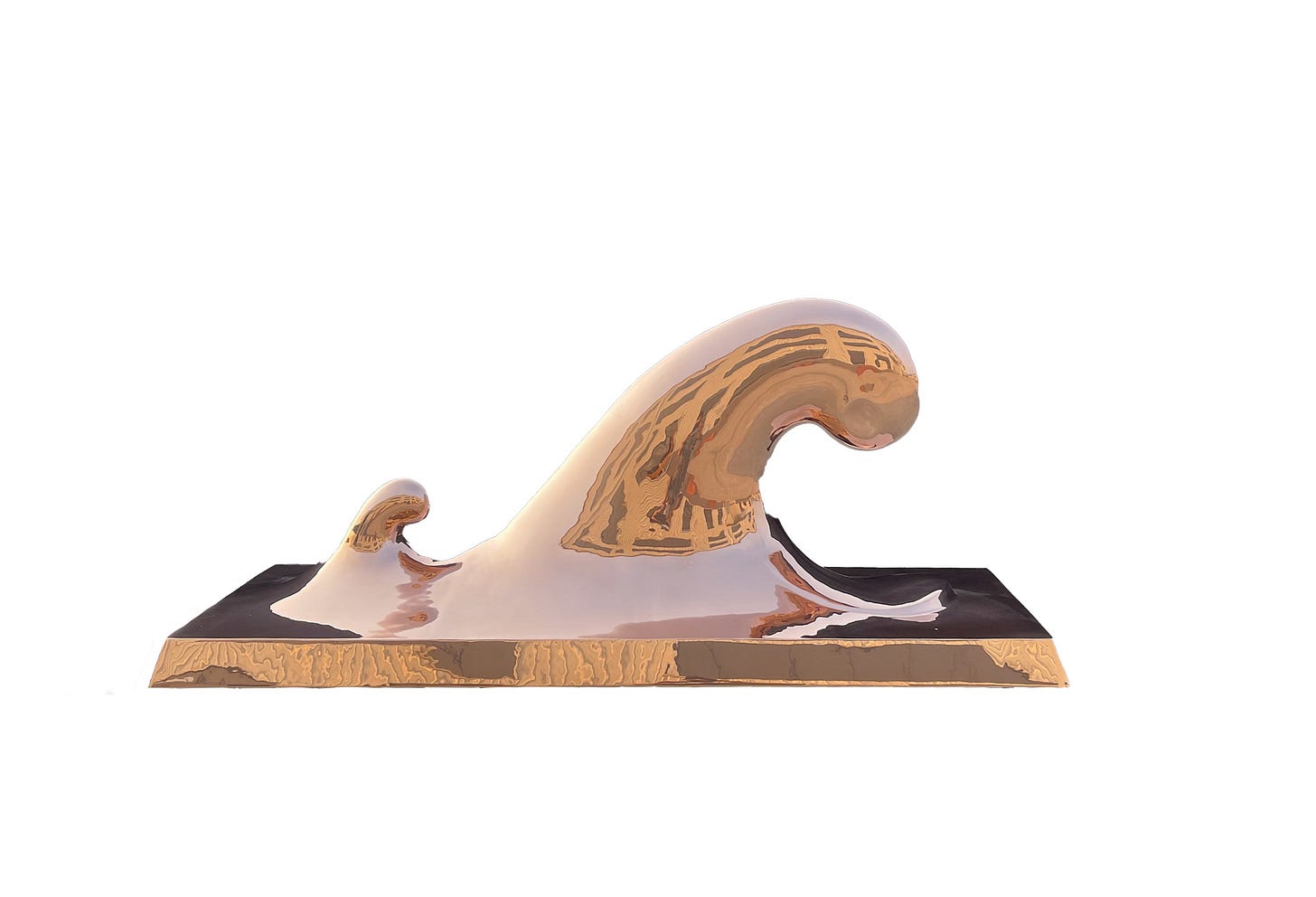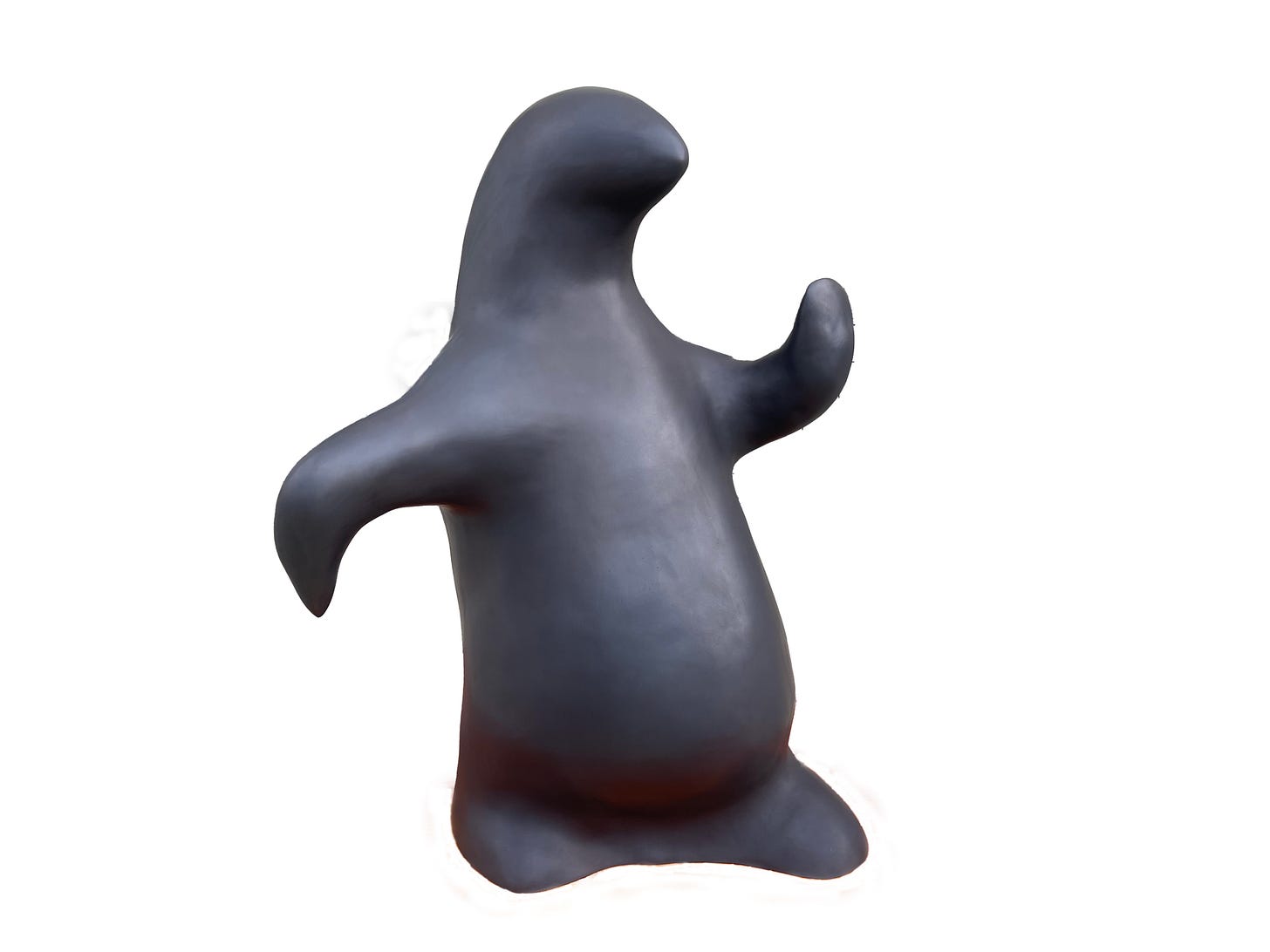
“Saint Clair Cemin” at Tobias Mueller Modern Art in Zurich, Switzerland, June 13-September 20, 2025
Sculpture, like any object fashioned with the intention of realizing an ideal—from a building, to a dress, to an automobile—achieves its final effect with the tangent between essence and appearance. Both are important, and though essence is difficult to perceive, it hides in the appearance, and in the range of associations it exhibits. The sculptor Saint Clair Cemin has chosen to make sculptures that manifest a specific manner of objecthood, and because they all possessed a certain grace. This grace was originally achieved with the use of curves, graceful turns that filled out their initial silhouettes, and defined them when their implied meaning was decidedly enigmatic. If anything could be said to be run through these works, it’s an excess of subtlety. They are hardly present in certain terms, yet form saves them. Their combination in one collection for the purpose of an upcoming exhibition was determined by their previous forms; each one lived a different life in another decade or century. Their value was likewise determined by Cemin’s interest in reinventing them in formal terms–diferent materials, different proportions and scales; and in reimaging them within his evolved practice in the interval of years since then. They have been given, in the contemporary parlance, Main Character Energy.
“Schnuller (Pacifier)” references a form that would otherwise be affiliated with seafaring navigation, the Propeller. It’s curious that an object that so resembles another so different in function can be transformed by altering the scale and the sculpted material, which comprises both its weight and its surface detail, can somehow be what it’s called while retaining the functional beauty of the original context for which it was made. A propeller and a pacifier couldn’t be more different: one moves ships or boats forward or backward, and the other silences and calms an upset child. This is the double face of progress, and just like two objects may easily resemble one another, so many words that seem to be pronounced similarly mean such different things. Clearly, the language of forms is not only one of straightforward definition, but one for which ambiguity also has a purpose.
This primordial form also operates in the work “Wave And Wave Jr.” This work, like its predecessor, symbolizes an elemental quality that evokes the real form itself independent of its symbolism. Cemin has captured the image of two waves–for no wave is ever singular, but one gesture in a continuous movement of elemental force, a liquid form of gravity affecting everything that lives within it and with which it makes contact. Yet in this instance the waves become a static object that projects an essence that in any other scene would be merely descriptive. One can observe and take in the quality of being a wave, appreciating it for its very stilled nature.
Two other sculptures possess a similar ambiguity that is wrought into their appearance and heightened by the language with which they were named. Both “Quote Unquote” and “Bearing” speak to the concept of personification, but they present its dimensions in different ways. “Quote Unquote” seems the more finished, as it not only presents an oblique figure emerging out of Rococoesque decoration, unlike BEARING, which is more minuscule in scale, and which relies upon a pedestal by which it is presented. The figure in “Bearing” feels like a primordial being slightly unbirthed, raw and with a sense of emptiness which, though it extends further into the concept of being, feels ghostly. The closer one inspects it, the less it seems to be an attempt at human or godlike form, it may seem symbolic but only appear similar to a body, since it’s primarily abstract, and feels more like a large industrial part to a larger machine. It’s only because it has a form implying humanness that it appeals to us in such a manner. It feels like a roughly hewn figure, having just departed by a few minor details from its original essence from elemental stone. What the work addresses is the need we may have to project essence into anything ambiguously inferring presence.
“Prometeo” is symbolic despite being both ambiguous and indistinct. It speaks to nature and the pure qualities of the elements. “Prometeo” is another way of saying Prometheus, one of the Titans, the gods who preceded the Olympians, whose existence is perhaps less known and understood. Prometheus is known as the first betrayer of the gods, who gave fire to mankind. But “fire” is a metaphor. It can also be interpreted as in the form of technology, knowledge and, more generally, civilization. The form of the sculpture is intentionally vague, as if what Cemin really means to infer is that the true intentions of a Titan can never truly be known. The Titans were the earlier deities that preceded the Olympians, and as such their personae have been obscured by time. Their role is as the extended family of Cronos, the father of Zeus. They have godlike authority without being known for specific powers or duties, and only Prometheus is well known for his one act of daring. The sculpture is like an archaeological fragment, charred and incomplete. We can only dream of how it realizes its inspired source, just as Prometheus himself could not foresee what fire would do for humanity. To raise man up it was necessary to inspire them beyond the expectations of their current state. Fire gave man an edge. Cemin uses “Prometeo” to invite us to dream of man’s fate and the role the gods had in it. His interpretation of the name in the title whispers of a promise kept.
Comedy and pathos are elements that inform and envelop two other sculptures by Cemin, “Russia” and “Tai Chi Penguin”. They are each similarly symbolic though much less oblique. Their essences are bound up in appearances dictated by associations or actions. “Russia” is the form of a bear, but not a realistic one. The object, with its diminutive scale and pinched features, feels more like a toy bear of a candy called a ‘gummy bear.’ which implies something more palliative and comforting than how we tend to think about a fellow Superpower nation. The symbol of a bear as representative of Russia goes back four centuries. “Representing both the good—strength, power and sheer might—and the bad—ferocity and club-footedness—it’s perhaps the only accurate likeness of the enigma that is Russia. Over the years it’s played many roles in Russian society; from an all-wise spirit god to be worshipped to a first-class fool, forced to drink wine and wear babushka scarves, to a symbol of wealth, ruthlessly hunted for its pelt, paws and organs.” (1) Yet in Cemin’s hands it becomes oblique, comical even. Is this political commentary? It’s a humanistic response to circumstances imposed upon the greater world. If it seems diminutive, it’s because the status of the nation is diminished by its recent actions. The form Cemin gives it is similarly symbolic in a manner that pushes our view of it into the realm of the iconic.
“Tai Chi Penguin” presents a comical figure, a cartoonish depiction of a penguin, borrowed as if from a Disney cartoon movie, of a penguin presenting a Tai Chi pose. Though having become a popular form of exercise that melds physical conditioning with mental focus, eschewing the notion that it promotes a meditative state, it was originally meant as training for combat. Taking an animal that presents as essentially peaceable, living its life in the glorious seclusion of the Arctic circle, or domestically in zoos, and placing it into a human-oriented activity is both celebratory of the cerebral ideal Tai Chi presents, and laudatory of it. As humans, we operate from a complex position of emotional expression. We take on certain disciplines in order to compel ourselves to somehow express the negative energy given to obsession or compulsion, transforming it into an action that can become habitual, and which represents a dispersion of energy and a focus upon well-being. The penguin doesn’t need such things (or does he?). So a penguin involved in human activities becomes either comedic or serious in an off-hand way. The energy projected by such a figure is such that it may compel us toward self-conscious reflection that ranges between the light-hearted and the ideal. It’s a heady subject for a sculpture, one that resists being iconic despite the finiteness of its form.
“Double Duck” is complementary to “Tai Chi Penguin” though it also presents as perverse. Its origin was a 1986 work called “Battle Duck” similarly small in stature but constructed in much warmer tones, combining marble and wood. “Double Duck” is more specifically prepared for conflict. Its appearance is the stacked image of two sole duck beaks. Its outward surface is concealed underneath plates of lead, giving its small size a heavy, almost dangerous look, like a version of reality cobbled together and sealed underneath an impermeable strata. It’s a cartoonish golem, small yet powerful. It’s presented inside a glass box, like a valuable specimen from a time unknown.
What unites all of the sculptures in this group is a certain surface consistency, a motif exerted by sensuous appeal alone. They are shaped by “curves in sequence” and have a distinct relationship to the body–not only their own, projected bodies, but the bodies of viewers, to whom they will always be metonymically compared. This body-image inflection carries with it a multitude of unconscious assumptions. The range of forms among the chosen works suggest things, and some even do things. As statues, they take on a degree of personism, projecting more than they own.
What is a symbol? The sculptures of Saint Clair Cemin ask this very question in every instance of their presentation. A symbol is often perceived as a static element representing some level of humanism or creed. When the symbol implies presence, or represents any instance in which the circumstance of its enactment of a certain range of meaning embodies presence, it places us into a certain relationship with the meaning of truth. There are essentially two kinds of presence in art, iconic and interpretive. Both contain a level of the symbolic while in some cases also projecting a degree of the human. We must be such egotistic creatures that we cannot conceive of even the most oblique object as representing anything other than ourselves. No matter how alien the form may appear, or if it’s meant as the extension of a metaphor emerging out of practical objects or those meant as decorative elements in construction, still we easily identify with some aspect of them that tells us who we are. The range of achieved effects in the current work of sculptor Saint Clair Cemin bring to mind such quandaries. Cemin brings the mystery and enjoys it in dimensions of pathos, joyful wisdom, and a gracious fear of the unknown that hides behind every curve.







the rhythm of the text is like that of the curves.. a progeny written wave mirroring the sculpted progenitor creating a three dimensionally illuminated manuscript that you can walk around in the space of time to see it frozen in space or keep moving around as it melts into descriptions in time. Just gazing at the work as it inspires one's own maybe somewhat similar reflections is not the same as experiencing internally -- I insist on reading slowly enough to hear the words -- the sound of somebody else's very well chosen and sculpted words as they flow with the same grace as the sculpture's lines. This is so appropriate to the artist's making sculpture out of language as much as matter and revealing their possibly identical twin nature however separated at birth. thank you.
I’m super busy at the moment so I haven’t had time to finish your text but I loved the first sentence: “ Sculpture, like any object fashioned with the intention of realizing an ideal—from a building, to a dress, to an automobile—achieves its final effect with the tangent between essence and appearance.”